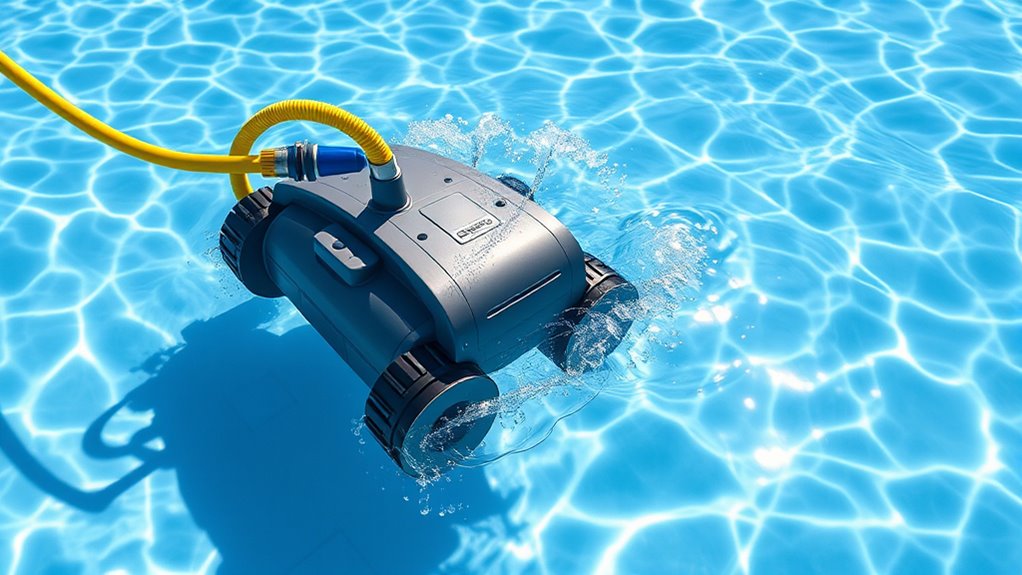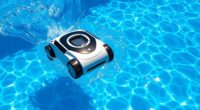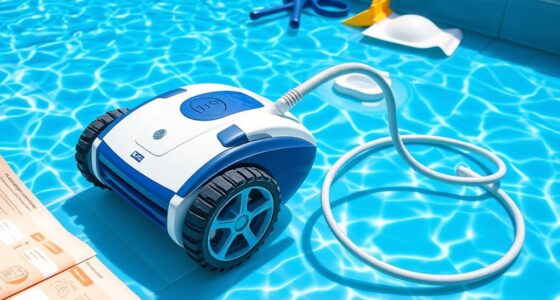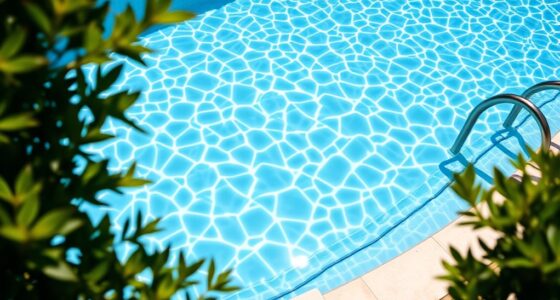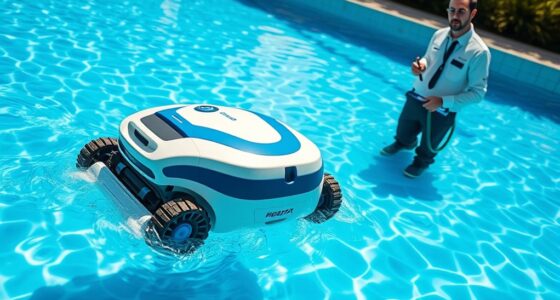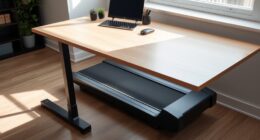Pressure pool cleaners work by using water pressure from your pool’s filtration system to move and clean your pool’s surface. The booster pump, hoses, and cleaner head work together to propel the cleaner, while jets and turbines powered by the pressurized water help it navigate and scrub surfaces effectively. Debris is sucked into a filtration system, trapping dirt and particles. Learn more to understand how these components coordinate for a cleaner pool.
Key Takeaways
- Water pressure from the pool’s pump powers the cleaner’s movement through hoses and nozzles.
- The booster pump generates water flow that drives the cleaner’s internal turbines or wheels.
- The cleaner head uses brushes or scrubbers to remove debris from the pool surface.
- Water flow is directed through nozzles to propel the cleaner and navigate around obstacles.
- Debris is sucked into a filtration system via intake ports, trapping particles for clearer water.
Components of a Pressure Pool Cleaner
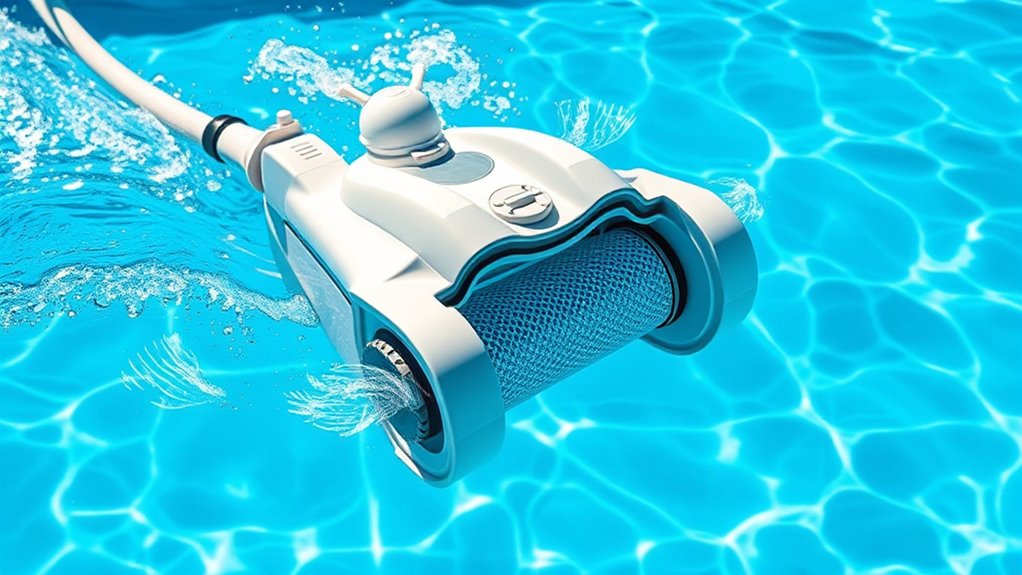
A pressure pool cleaner relies on several key components working together to keep your pool spotless. The main parts include a booster pump, hoses, and the cleaner head. The booster pump generates water flow, which powers the movement of the cleaner. As water flows through the system, it creates pressure that propels the cleaner across the pool surface. The hoses connect the pump to the cleaner head, guiding water and debris away from the surface. The cleaner head, often equipped with brushes or scrubbers, scrapes algae and dirt from the pool surface. These components work in harmony, using water flow to navigate the pool and effectively remove debris, ensuring your pool stays clean with minimal effort on your part. Advances in automation technologies are also being integrated into modern pool cleaning systems to improve efficiency. Properly designed pressure systems help maximize cleaning performance and reduce the need for manual skimming. Additionally, regular maintenance of the system components—such as checking for component wear—can extend their lifespan and ensure consistent cleaning results.
How Water Flows Through the System
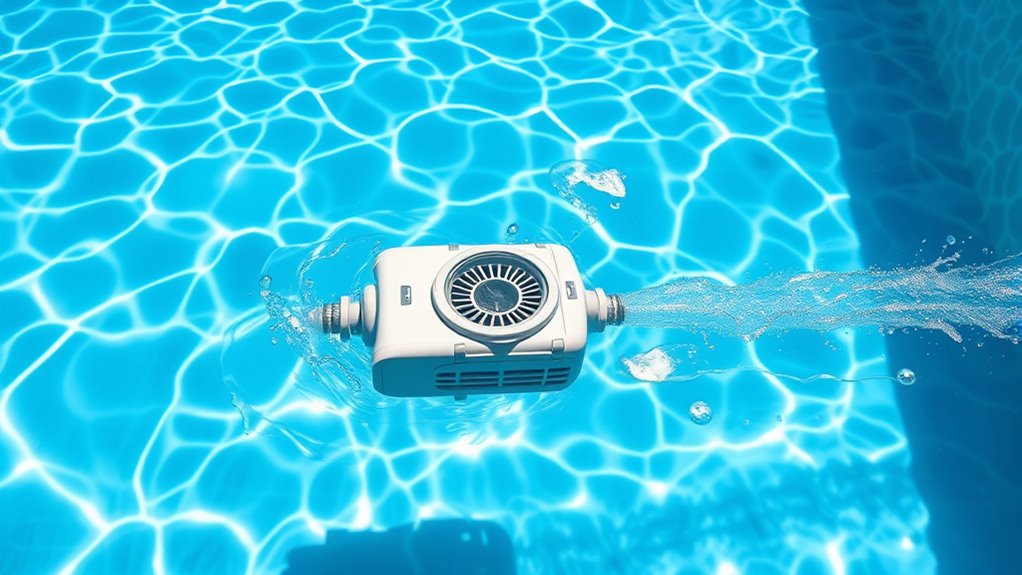
Have you ever wondered how water moves through a pressure pool cleaner to keep your pool spotless? It all starts with water pressure from your pool’s pump, which forces water into the cleaner via a hose. This pressure creates a flow rate that powers the internal jets and turbines, driving the cleaner across the pool surface. As water flows through the system, it passes through various nozzles and passages designed to optimize movement and cleaning efficiency. The higher the water pressure, the more forcefully the cleaner operates, while the flow rate determines how much water passes through the system each second. This controlled flow ensures your cleaner effectively scrubs debris and dirt, leaving your pool pristine.
The Role of the Drive Mechanism
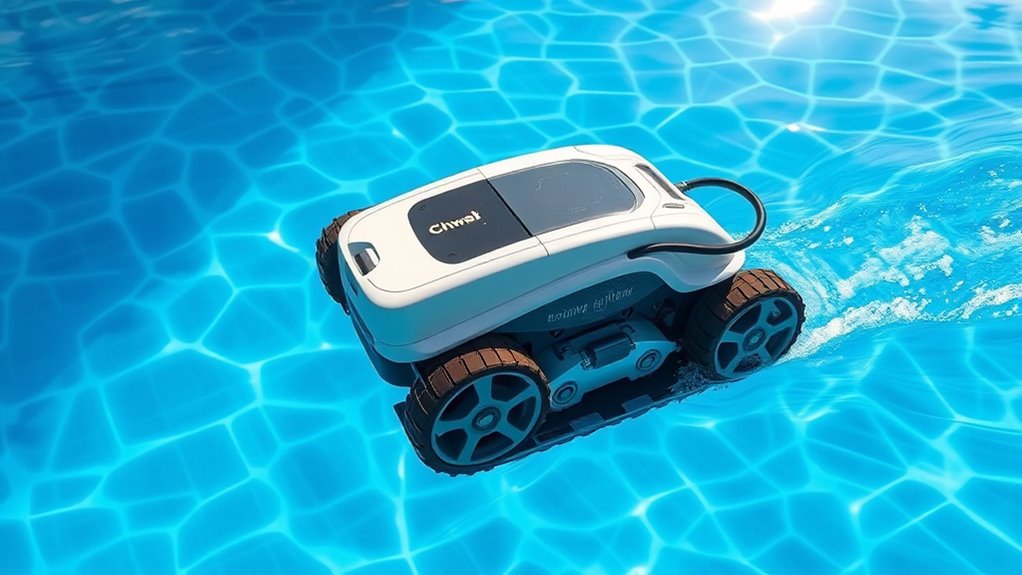
The drive mechanism is what propels the pressure pool cleaner across the surface of your pool. It relies on a drive system that converts the energy from the power source into movement. Most pressure cleaners use water pressure generated by the pump to power the drive system, often through turbines or wheels connected to the drive mechanism. The power source, typically your pool’s pump, supplies the pressure needed to operate the drive system efficiently. As water flows through the cleaner, the drive mechanism harnesses this energy to move the unit smoothly over the pool surface. This movement allows the cleaner to reach different areas, ensuring thorough cleaning without manual effort on your part. Proper drive system design ensures the cleaner operates efficiently and covers the entire pool surface effectively. Additionally, drive mechanism efficiency plays a crucial role in reducing energy consumption and prolonging the lifespan of the cleaner. Optimizing the drive components can further enhance overall performance and reliability, especially through effective component design that minimizes wear and tear.
Navigation and Movement Strategies
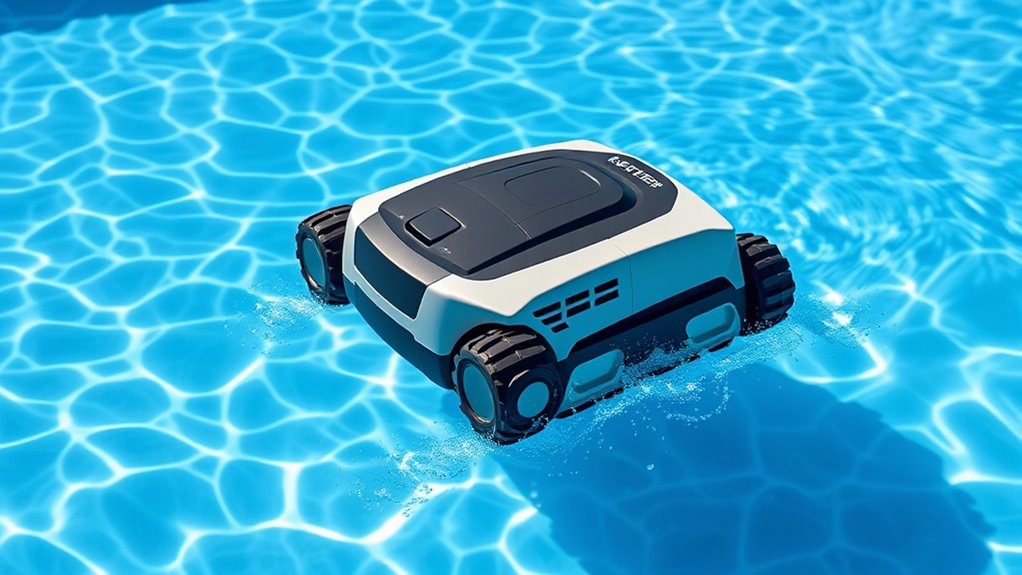
Pressure pool cleaners use various navigation and movement strategies to effectively cover all areas of your pool’s surface. They often rely on a combination of programmed patterns and reactive adjustments to guarantee thorough cleaning. Some models use swiveling hoses or internal sensors to change direction when they encounter obstacles or edges, minimizing missed spots. This improves cleaning efficiency by reducing the time it takes to clean the entire pool. Additionally, efficient navigation helps conserve energy consumption, as the cleaner avoids unnecessary movements or repeated passes over the same areas. By intelligently maneuvering around the pool, these cleaners maximize coverage while using minimal power, making them both effective and energy-efficient options for maintaining a clean swimming environment. Incorporating navigation strategies that adapt to pool layouts further enhances their effectiveness and ensures comprehensive coverage. The use of sensor technology allows for better detection of obstacles and edges, further improving the cleaner’s ability to adapt to different pool shapes and sizes. Moreover, advanced models often integrate adaptive algorithms that optimize movement patterns based on the pool’s specific features, ensuring no area is overlooked. Implementing real-time adjustments enables these cleaners to respond promptly to changes in the pool environment, further increasing their cleaning efficiency.
Debris Collection and Filtration
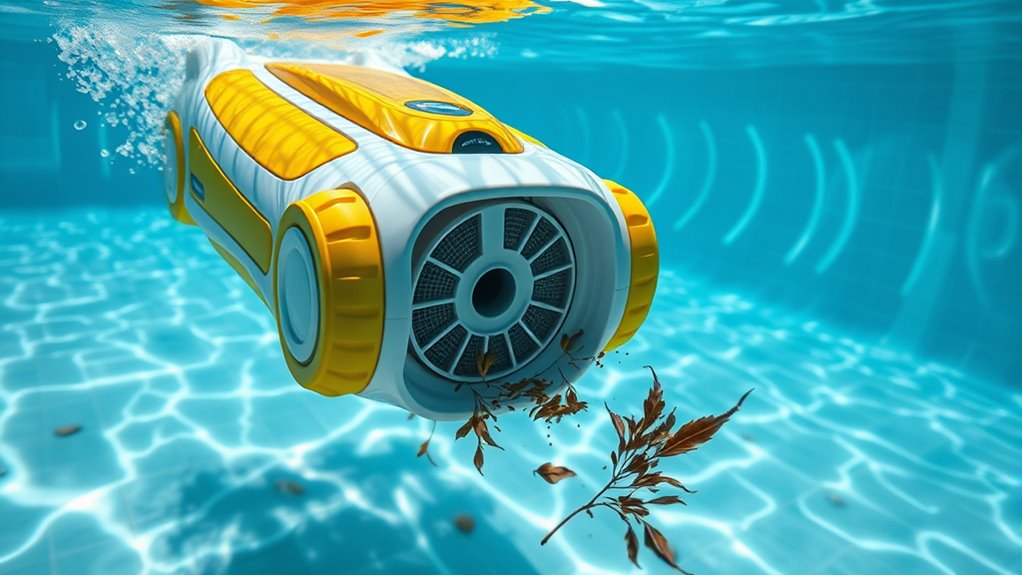
Ever wonder how pressure pool cleaners efficiently remove debris from your pool? It all starts with their debris pickup system. As the cleaner moves across the pool surface, it uses powerful jets to loosen dirt, leaves, and other debris. The debris gets sucked into a dedicated intake port connected to a filtration system. Inside, the filter traps particles, preventing them from recirculating into the water. Some models have fine mesh filters that catch even small debris, ensuring crystal-clear water. Electric pressure pool cleaners often incorporate advanced features to enhance cleaning efficiency and reduce manual effort. The continuous debris collection keeps the pool surface clean without you needing to lift a finger. Regularly checking and cleaning the filter ensures ideal debris pickup and prevents clogs. Proper maintenance of the filtration system can significantly improve the overall performance of your cleaner. Overall, this combination of effective debris collection and filtration keeps your pool looking pristine. Additionally, professional-grade filters can enhance the efficiency of debris removal and extend the lifespan of your pool equipment.
Benefits and Limitations of Pressure Cleaners
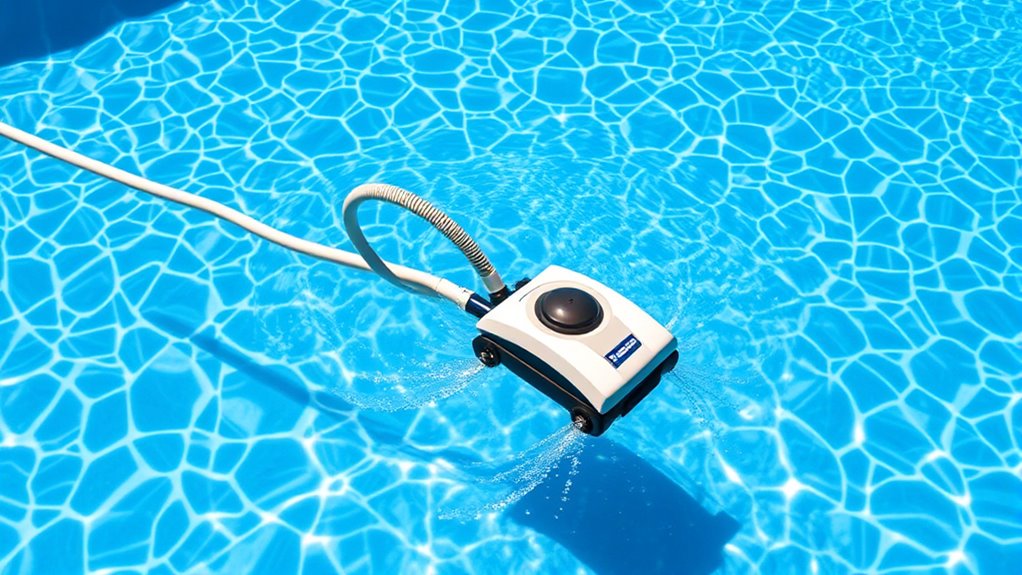
While pressure pool cleaners effectively keep your pool surface debris-free, they also come with certain advantages and drawbacks. One key benefit is that they improve water circulation, helping distribute chemicals evenly and prevent algae growth. They’re also easy to operate and can cover large areas quickly, making pool maintenance more efficient. However, their reliance on external pressure sources, like a booster pump, can increase energy costs. Additionally, they may struggle with tight corners or steps, leaving some areas unclean. Pressure cleaners can sometimes dislodge debris but not always remove fine particles, requiring supplementary cleaning methods. Overall, they’re a valuable tool for maintaining a clean pool, but understanding their limitations ensures you choose the right cleaning approach for your specific needs.
Frequently Asked Questions
Can Pressure Pool Cleaners Clean Algae and Bacteria Effectively?
Pressure pool cleaners can effectively handle algae removal and bacteria control. They use high-pressure jets to scrub and vacuum surfaces, removing algae and bacteria buildup efficiently. You’ll notice clearer water and better sanitation because these cleaners target algae and bacteria directly, reducing the need for chemical treatments. Regular use keeps your pool cleaner, healthier, and algae-free, making maintenance easier and ensuring a safer swimming environment for you and your family.
How Long Does It Typically Take for a Pressure Cleaner to Clean a Pool?
Did you know that a pressure pool cleaner can typically finish a full pool cycle in about 1 to 3 hours? The cleaning duration depends on factors like pool size, debris buildup, and the cleaner’s efficiency. Usually, you’ll see thorough cleaning within this time frame, making it a convenient option for regular maintenance. For a standard pool, expect the cleaner to complete its cycle comfortably within a few hours.
Are Pressure Pool Cleaners Suitable for All Pool Shapes and Sizes?
You’ll find pressure pool cleaners are generally suitable for most pool shapes and sizes, but it’s important to consider pool shape compatibility and pool size limitations. They work best in rectangular or oval pools and may struggle with complex shapes or tight corners. Check the manufacturer’s specifications to ensure your pool’s shape and size fit the cleaner’s capabilities, ensuring effective cleaning without damage or inefficiency.
What Maintenance Is Required to Keep a Pressure Pool Cleaner Functioning?
To keep your pressure pool cleaner working well, you need to do regular filter maintenance and motor inspection. Check and clean the filter basket often to prevent clogs, and inspect the motor for any signs of wear or leaks. Also, verify hoses are free of debris and securely connected. Performing these simple tasks will extend your cleaner’s lifespan and keep your pool sparkling clean.
Do Pressure Pool Cleaners Work Well With Saltwater Pools?
Imagine you’re cleaning a saltwater pool, and your pressure cleaner works seamlessly. These cleaners are generally saltwater compatible, making them a great choice. Their design also offers pool shape adaptability, ensuring thorough cleaning regardless of the pool’s shape. For example, a homeowner with a freeform saltwater pool found that their pressure cleaner handled corners and curves well, proving it’s effective even in complex pool designs.
Conclusion
Think of a pressure pool cleaner as your pool’s diligent gardener, tirelessly tending each corner. It uses the power of water like a gentle stream guiding a boat, smoothly steering and collecting debris along the way. Though it’s a hardworking helper, it’s not perfect—sometimes missing a leaf or two. Still, with its steady flow and strategic movement, it keeps your pool sparkling, just like a well-tended garden, ready for you to enjoy.

